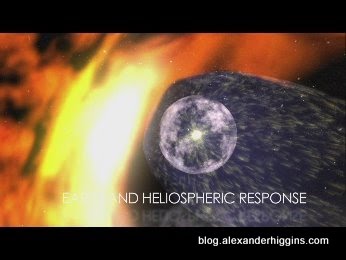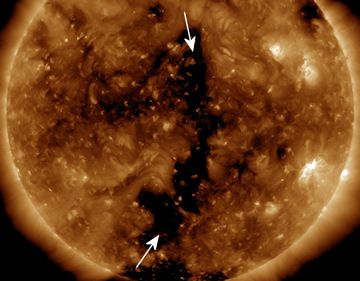NASA is warning that the Earth is on a collision course with a solar flare that could wipe out electronics, satellites and communication systems across the globe that humanity has become so reliant on in the 21 st century and is calling for the Government to organize the necessary preparations needed to prevent detect upcoming solar activity that can wreak havoc on humanity.


The “Earth and space are about to come into contact in a way that’s new to human history. To make preparations, authorities in Washington DC are holding a meeting: The Space Weather Enterprise Forum at the National Press Club on June 8th” reports the NASA article.


From the NASA Space Weather Web Site SpaceWeather.com
“NASA’s Solar Dynamics Observatory is monitoring a dark rift in the sun’s atmosphere. The spacecraft’s Atmospheric Imaging Assembly (AIA) took this extreme ultraviolet picture just hours agoIt’s a “coronal hole,” a vast region where the sun’s magnetic field has opened up and allowed the solar wind to escape. Indeed, a solar wind stream flowing from this hole is heading toward Earth, due to arrive on June 7th or 8th. High latitude sky watchers should be alert for auroras on those dates.
The National Academy of Sciences framed the problem two years ago in a landmark report entitled “Severe Space Weather Events—Societal and Economic Impacts.” It noted how people of the 21st-century rely on high-tech systems for the basics of daily life. Smart power grids, GPS navigation, air travel, financial services and emergency radio communications can all be knocked out by intense solar activity. A century-class solar storm, the Academy warned, could cause twenty times more economic damage than Hurricane Katrina.
“The sun is waking up from a deep slumber, and in the next few years we expect to see much higher levels of solar activity. At the same time, our technological society has developed an unprecedented sensitivity to solar storms. The intersection of these two issues is what we’re getting together to discuss.”
Much of the damage can be mitigated if managers know a storm is coming. Putting satellites in ‘safe mode’ and disconnecting transformers can protect these assets from damaging electrical surges. Preventative action, however, requires accurate forecasting—a job that has been assigned to NOAA.
“Space weather forecasting is still in its infancy, but we’re making rapid progress,” says Thomas Bogdan, director of NOAA’s Space Weather Prediction Center in Boulder, Colorado.


Bogdan sees the collaboration between NASA and NOAA as key. “NASA’s fleet of heliophysics research spacecraft provides us with up-to-the-minute information about what’s happening on the sun. They are an important complement to our own GOES and POES satellites, which focus more on the near-Earth environment.”
Just last week, scientists working with NASA’s new Solar Dynamics Observatory (SDO) released the most astonishing movies of the sun anyone had ever seen.


